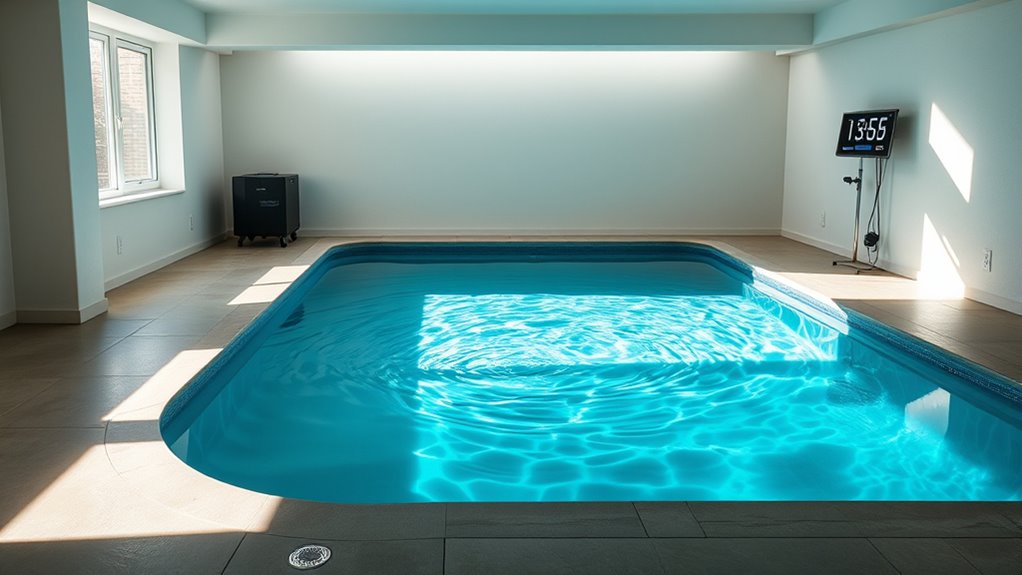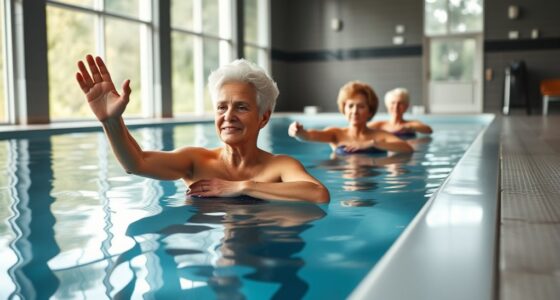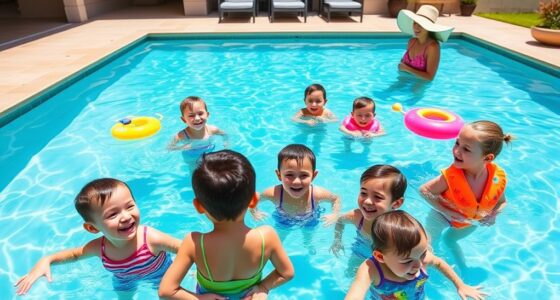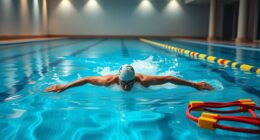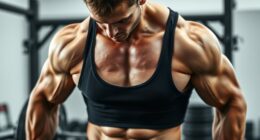Endless pools typically use between 1.5 and 3 kWh of energy per hour, depending on factors like size, features, and settings. Your pump, heater, and seasonal adjustments all influence power consumption. You can cut costs by using energy-efficient equipment, setting the pool heater to a comfortable but lower temperature, and using timers or covers. Want more tips on lowering your pool’s energy use? Keep exploring to learn proven strategies.
Key Takeaways
- Endless Pool energy use typically ranges from 1.5 to 3 kWh per hour, costing about $0.20 to $0.40 per hour.
- Larger pools and feature-rich models consume more power due to bigger pumps, heaters, and extra features.
- Using energy-efficient pumps, insulating the pool, and installing covers can significantly reduce power draw.
- Setting pumps to lower speeds, maintaining optimal heater temperatures, and scheduling operation during off-peak hours cut costs.
- Monitoring energy consumption with smart meters helps identify savings opportunities and optimize overall pool energy efficiency.
Understanding the Typical Power Consumption of Endless Pools

Understanding how much power an endless pool uses is essential for managing your energy costs. On average, these pools consume between 1.5 to 3 kilowatt-hours (kWh) per hour of operation. This varies depending on the size, model, and features you choose. For example, a basic model with a smaller motor will use less energy compared to larger, more feature-rich versions. Running your pool continuously for an hour might cost you around $0.20 to $0.40, based on typical electricity rates. Keep in mind that the actual power draw can fluctuate depending on how often you use the pool and its settings. Additionally, home energy efficiency measures can significantly impact your overall electricity consumption, helping you save money while enjoying your pool. Knowing these numbers helps you plan your energy budget and identify opportunities to reduce consumption without sacrificing your swimming experience.
Key Factors That Influence Energy Use in Your Pool

Several factors can cause variations in your endless pool’s energy consumption, making it important to contemplate what influences its power use. First, the pool’s size and volume impact energy needs, as larger pools require more power to heat and circulate water. Second, the temperature you set plays a vital role; higher temperatures demand more energy to maintain. third, how often and how long you use your pool affects overall consumption — frequent, extended sessions increase energy use. Additional factors include insulation quality, which can reduce heat loss, and equipment efficiency, as newer, energy-efficient pumps and heaters consume less power. For example, Kia Tuning options such as upgraded pumps and heaters can improve energy efficiency. By understanding these elements, you can identify areas to optimize and reduce your pool’s energy costs effectively.
Comparing Different Models and Their Energy Efficiency
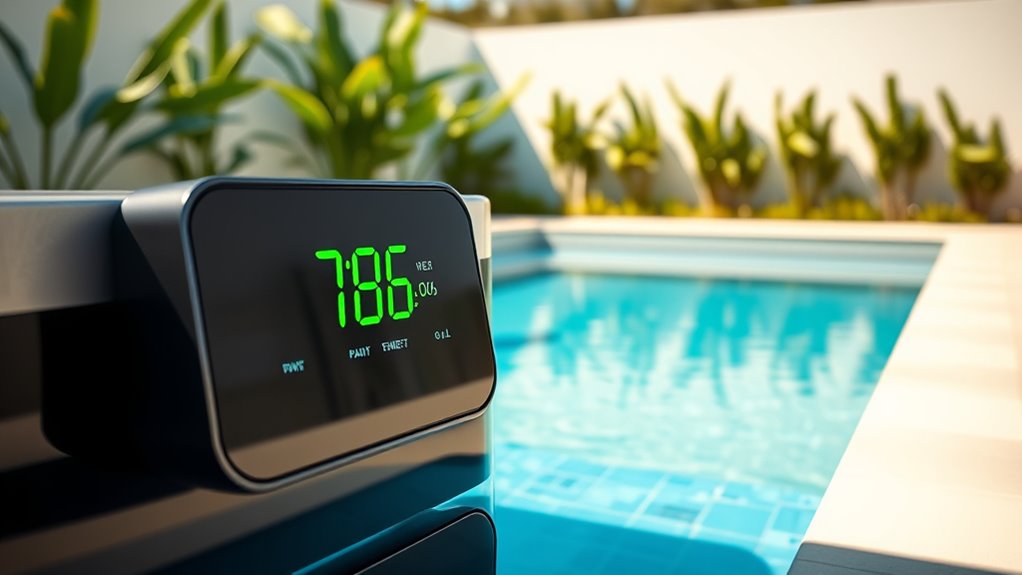
When comparing different model options, you’ll notice that energy consumption can vary considerably. Some models use advanced features that boost power use, while others prioritize efficiency to save energy. Understanding these differences helps you choose a pool that balances performance with energy savings. Incorporating energy-efficient designs can significantly reduce ongoing operational costs over time.
Model Energy Consumption Differences
Different Endless Pool models vary considerably in their energy consumption, making it important to compare their efficiency directly. Higher-end models often feature advanced insulation, more efficient pumps, and smarter controls, which reduce power use. Conversely, simpler models may lack these features, leading to higher energy costs. To help you evaluate, consider these key differences: 1. Insulation Quality: Better insulation minimizes heat loss, decreasing heater and pump workload. 2. Pump Efficiency: More efficient pumps use less electricity while maintaining performance. 3. Control Systems: Smart controls optimize operation, preventing unnecessary energy use during idle times. Additionally, assessing the energy-saving features integrated into each model can significantly impact overall consumption.
Features Impact Power Use
Features such as insulation quality, pump efficiency, and control systems directly influence an Endless Pool’s energy use. A well-insulated model retains heat better, reducing the workload on your heater and lowering energy costs. Efficient pumps consume less power while maintaining *ideal* water circulation. Modern control systems allow you to customize operation, turning equipment on or off when needed, preventing unnecessary power consumption. Some models include energy-saving modes or variable-speed pumps that adapt to your usage, further cutting energy use. When comparing different models, look for features that enhance energy efficiency without sacrificing performance. Investing in a pool with advanced insulation, efficient pumps, and smart controls will help you save money over time and reduce your environmental impact.
How Pool Size and Features Impact Power Draw
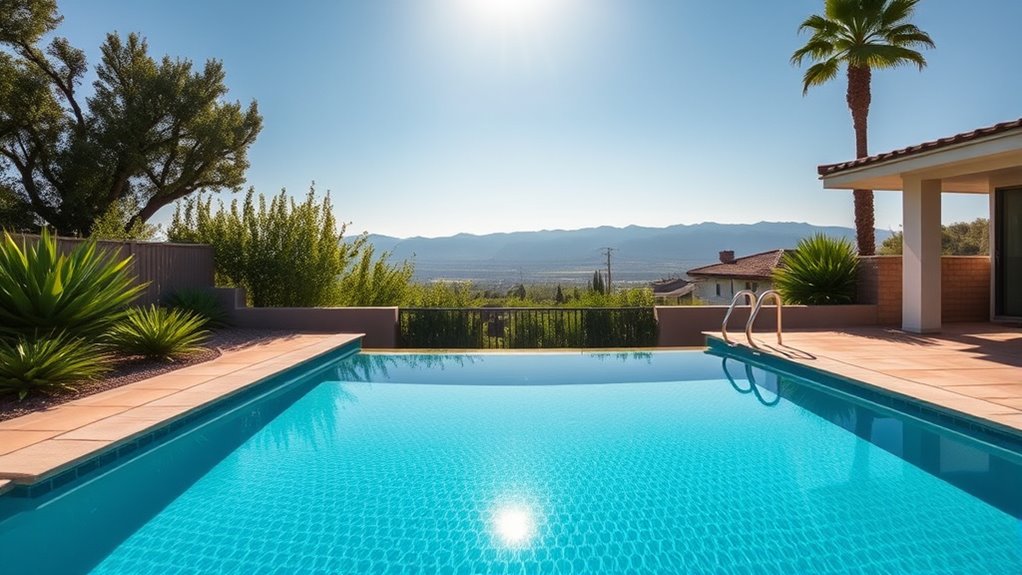
Larger pools generally require more energy to operate because they need more powerful pumps and heating systems to maintain water quality and temperature. The size of your pool directly influences power consumption, as bigger volumes demand increased filtration and heating effort. Features like jets, waterfalls, or lighting also add to energy use by requiring additional power. To understand how size and features impact your energy bill, consider:
- Pool volume – more water means longer heating times and stronger pumps.
- Additional features – waterfalls, jets, and lighting increase electrical load.
- Insulation and cover use – better insulation reduces heat loss, lowering energy needs.
- Bedroom-inspired design: While not directly related to pools, integrating energy-efficient lighting and insulation techniques from cozy farmhouse bedrooms can help reduce overall energy consumption around your property.
Choosing a smaller pool or limiting features can profoundly decrease your energy consumption, saving you money in the long run.
The Role of Pump and Heater Settings in Energy Use

Your pump speed and heater settings directly affect how much energy your pool uses. Running the pump at higher speeds or setting the heater too high can boost power consumption markedly. Adjusting these settings for efficiency helps you save energy without sacrificing comfort. Incorporating advanced control features can further optimize energy use and enhance overall system performance.
Pump Speed Efficiency
Since pump speed directly influences energy consumption, optimizing its settings can lead to significant savings. Running your pump at the lowest effective speed minimizes power use while maintaining water circulation. Higher speeds increase energy draw without always improving efficiency. To optimize pump speed:
- Keep the pump at the lowest speed that still maintains water clarity and circulation.
- Adjust the speed based on pool usage—use lower speeds during off-peak times.
- Regularly clean and maintain filters to ensure the pump works efficiently without needing higher speeds.
Heater Temperature Settings
Adjusting your heater temperature settings plays a significant role in controlling energy use, especially when combined with pump operation. Setting your heater too high causes it to work harder and consume more power, increasing overall energy costs. Conversely, lowering the temperature reduces the heater’s workload, saving energy. It’s important to find a comfortable balance—most pools operate efficiently around 78-80°F. Keep in mind that the heater runs primarily when the pump circulates water, so reducing pump run times also decreases heating demands. Regularly monitoring your pool’s temperature helps prevent unnecessary heating, especially during periods of low use or maintenance. By fine-tuning your heater settings, you can optimize energy efficiency without sacrificing comfort.
Optimal Energy Consumption
Optimizing energy consumption in your endless pool involves carefully balancing both pump and heater settings. Proper adjustments can markedly reduce power use without sacrificing comfort. First, set your pump to operate during off-peak hours or use a variable-speed pump to match your usage needs. Second, maintain your heater at the lowest comfortable temperature to minimize energy draw. Third, consider installing a timer to schedule pump and heater operation, avoiding unnecessary running times. These steps help prevent wasteful energy use, ensuring your pool operates efficiently. Additionally, monitoring your juice detox and other dietary habits can influence your overall energy levels and health. By fine-tuning these settings, you can enjoy your pool while keeping energy costs low. Remember, small adjustments make a big difference in optimizing your pool’s energy consumption.
Seasonal Variations in Energy Consumption
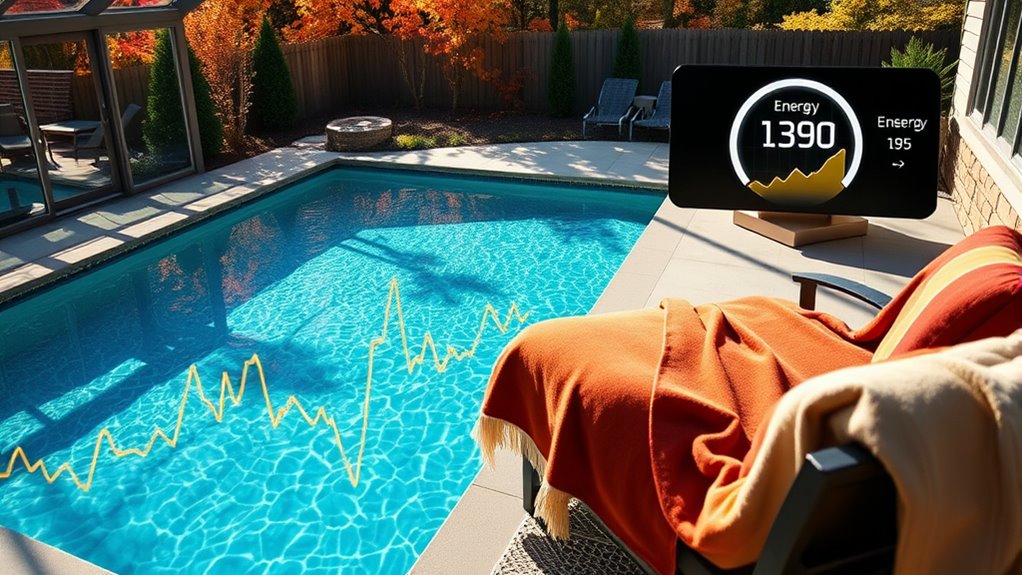
Energy consumption for an endless pool fluctuates considerably across different seasons, influenced by external temperatures and user habits. During colder months, your heater works harder to maintain water temperature, increasing energy use. Conversely, in warmer seasons, less heating is needed, reducing power consumption. These variations depend on factors like climate, pool insulation, and how often you swim or use the pool. Understanding seasonal changes helps you plan for energy costs and optimize usage. Here’s a quick overview:
| Season | Typical Energy Use | Key Influences |
|---|---|---|
| Winter | Highest | External cold, heating demands |
| Spring | Moderate | Warmer weather, less heating needed |
| Summer | Lowest | Minimal heating, natural warmth |
| Fall | Moderate | Cooler evenings, increased heating |
| Transition | Fluctuates | Changing temperatures, usage patterns |
Knowing these patterns helps you manage costs effectively and optimize energy efficiency.
Tips for Reducing Energy Costs While Enjoying Your Pool
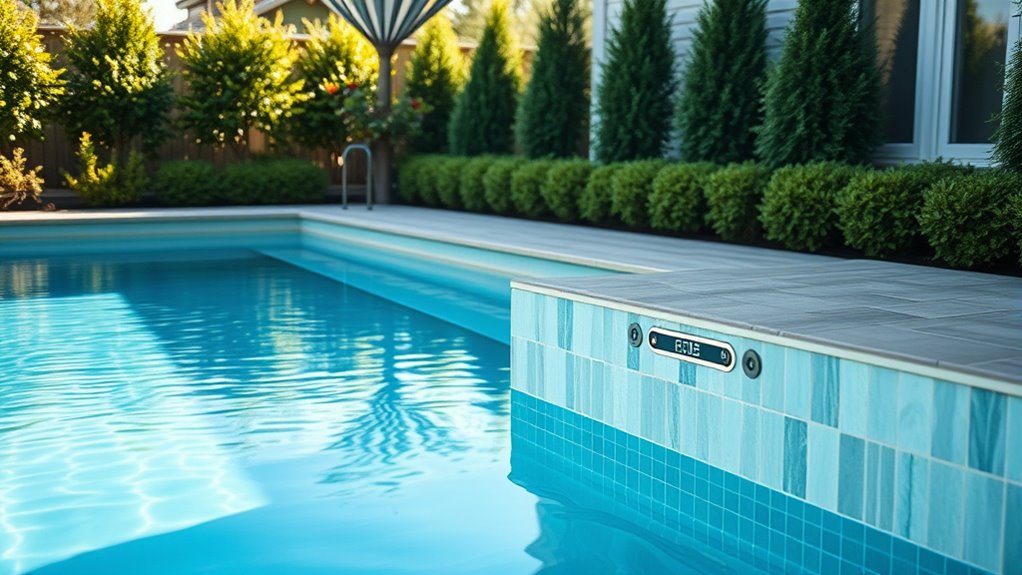
To keep your pool costs down without sacrificing enjoyment, focus on simple strategies that minimize energy use while you’re using the water. First, limit your pool time to avoid unnecessary energy consumption. Second, maintain a consistent, comfortable water temperature—heating only when needed prevents waste. Third, turn off the jets and lights when not in use, as they can draw significant power even during downtime. Additionally, consider using a pool cover during breaks to retain heat and reduce evaporation. These small adjustments help cut energy costs without taking away from your pool experience. By being mindful of how and when you use your pool’s features, you can enjoy your water while keeping your energy bills in check. Proper angle adjustment of your equipment can also improve efficiency and reduce energy use over time.
Installing Energy-Saving Technologies and Accessories
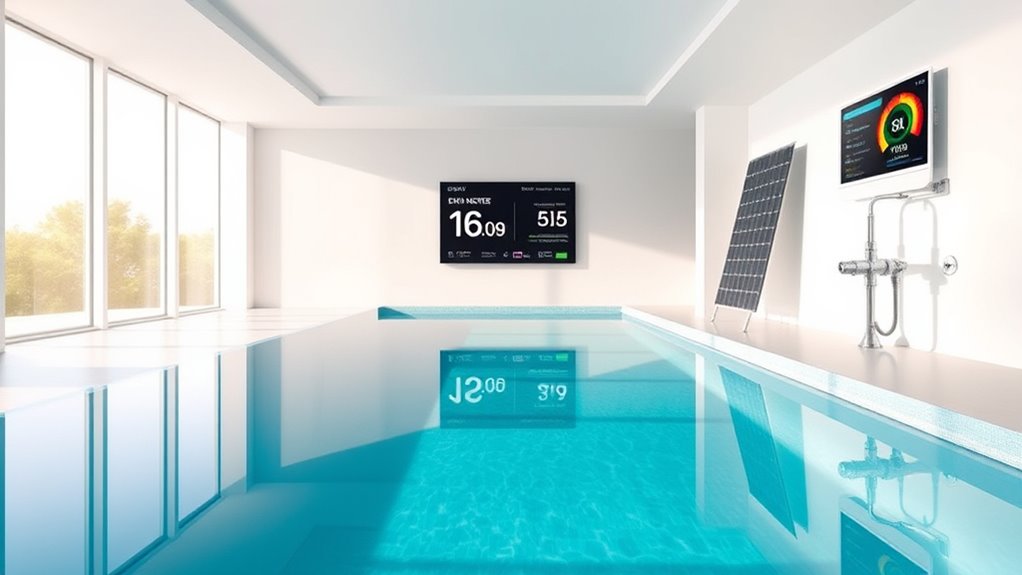
Installing energy-saving technologies and accessories can substantially reduce your pool’s overall power consumption. For example, adding a high-efficiency pump can lower energy use compared to standard models. Insulating your pool’s equipment and plumbing helps retain heat, reducing the workload on your heater. Consider installing a cover when the pool isn’t in use; it minimizes heat loss and reduces evaporation, which can save energy and water. You might also upgrade to LED lighting, which consumes less power than traditional bulbs. Additionally, using variable-speed pumps allows you to adjust flow rates based on your needs, optimizing efficiency. These upgrades not only cut energy costs but also extend the lifespan of your equipment, making your pool more eco-friendly and cost-effective over time. Implementing proper installation planning resources ensures your upgrades are both effective and sustainable.
Monitoring and Managing Your Pool’s Power Usage Effectively
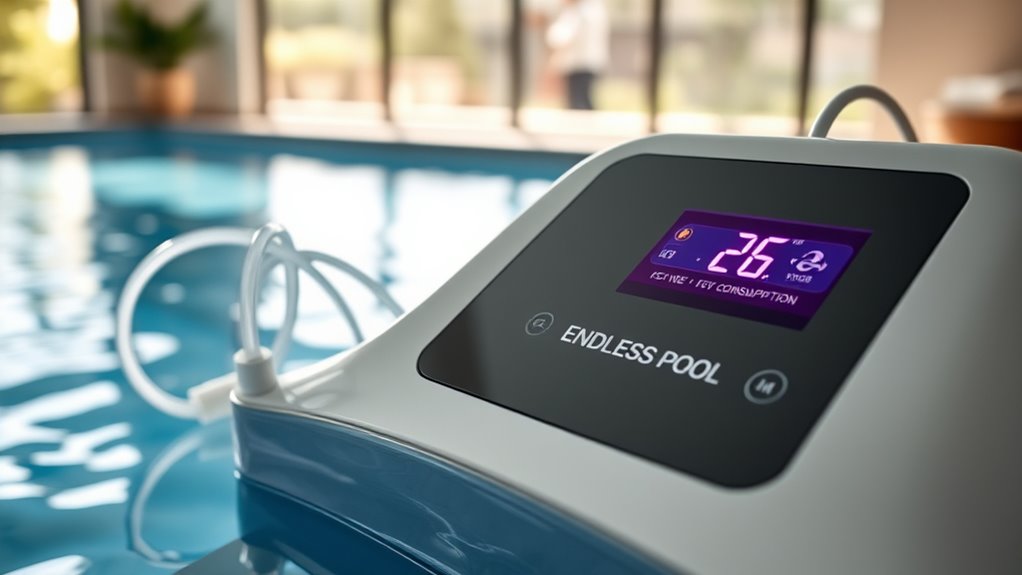
Keeping track of your pool’s power usage is essential for identifying areas where you can save energy and reduce costs. Regular monitoring helps you understand how different factors affect consumption. To do this effectively, consider these steps:
- Use energy meters or smart plugs to measure real-time power draw from your pool equipment.
- Keep a log of energy usage during different times of day and varying conditions.
- Adjust your pool’s operation schedule based on the data, such as running the heater or pump during off-peak hours.
Frequently Asked Questions
How Long Does It Typically Take to See Savings After Upgrading Pool Equipment?
You’ll usually see savings within a few months after upgrading your pool equipment. Modern, energy-efficient pumps and heaters work more effectively, so your bills drop quickly once you start using them consistently. The exact time varies based on usage and the specific upgrades, but most people notice a difference in their energy costs within 2 to 3 billing cycles. Keep using your new equipment regularly to maximize those savings.
Are There Specific Brands Known for Lower Energy Consumption?
Did you know some brands reduce energy use by up to 30%? If you’re looking for lower energy consumption, consider energy-efficient models from brands like Endless Pools, which use advanced pumps and insulation. You can save more by choosing variable-speed pumps and energy-efficient heaters. These brands focus on minimizing power draw, making your pool more eco-friendly and cost-effective, helping you enjoy your pool without high energy bills.
Can Pool Covers Significantly Reduce Energy Costs?
Yes, pool covers can considerably cut your energy costs by trapping heat and reducing evaporation. When you use a cover, you keep the water warmer longer, meaning your heater doesn’t have to work as hard. This not only saves energy but also lowers your utility bills. Make sure to choose a high-quality, insulated cover to maximize these benefits and keep your pool warm efficiently.
What’s the Average Lifespan of Energy-Efficient Pool Components?
You can expect energy-efficient pool components to last around 5 to 15 years, depending on usage and maintenance. Pumps and filters typically endure 5 to 10 years with proper care, while heaters and automation systems may last up to 15 years. Regular maintenance, such as cleaning filters and checking for wear, helps prolong their lifespan. Investing in quality components and timely upgrades also ensures you get the most out of your pool equipment.
How Does Climate Influence Pool Energy Consumption Over the Year?
Climate greatly impacts your pool’s energy use throughout the year. In colder months, you might see energy consumption increase by up to 50% because you need to run your heater longer to maintain ideal water temperature. Conversely, in warmer weather, less heating is necessary, reducing energy costs. Understanding your climate helps you maximize your pool’s operation, saving money and energy while keeping your pool comfortable year-round.
Conclusion
By understanding your pool’s energy needs, choosing efficient models, adjusting settings, and installing smart technologies, you can cut costs and enjoy your endless pool more. Monitor your usage regularly, optimize your pump and heater settings, and consider seasonal adjustments to save energy year-round. Stay proactive, stay informed, and stay committed to reducing your pool’s power draw—making every swim more sustainable, affordable, and enjoyable.

